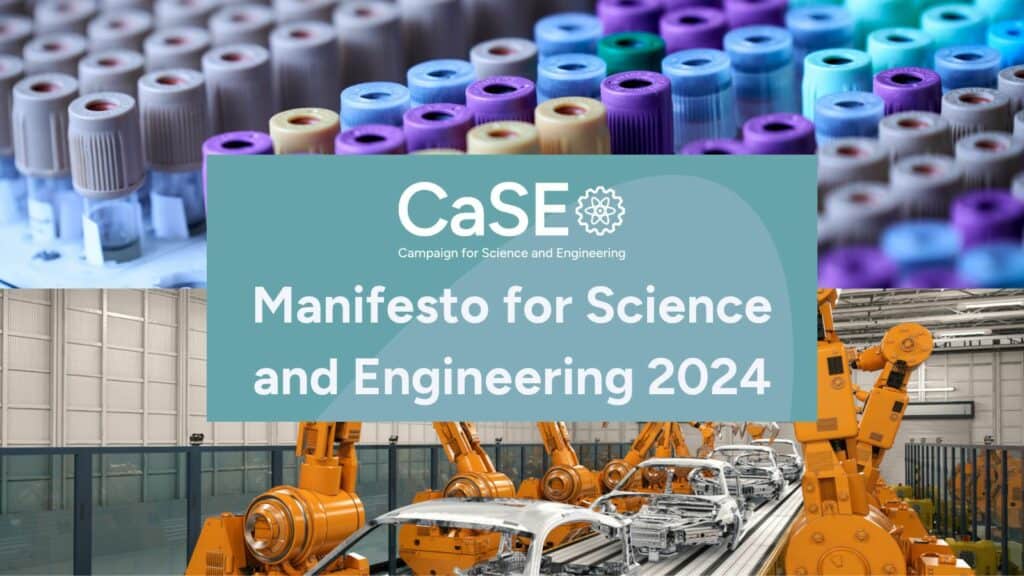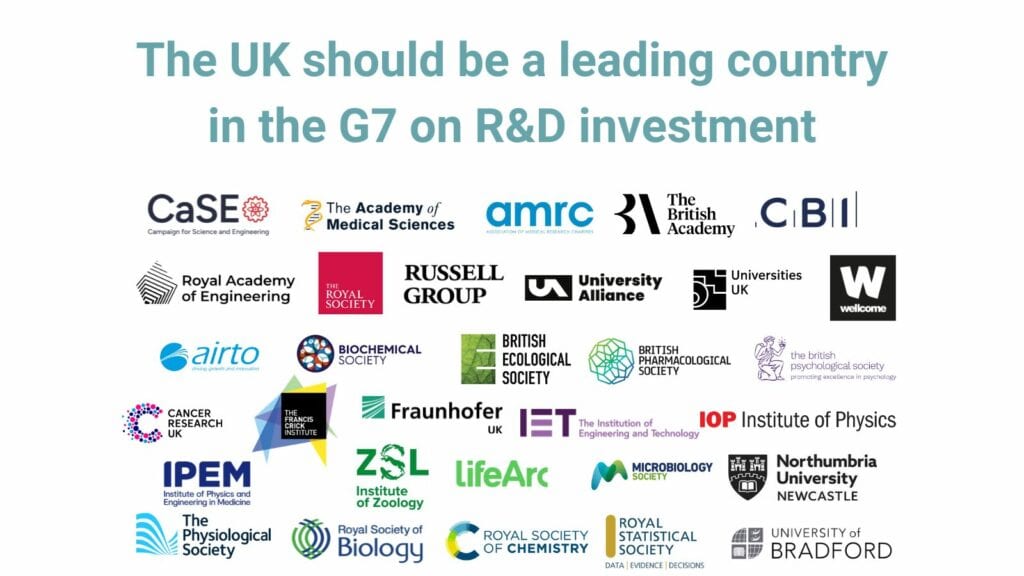Monday 29th November 2021 saw the science and engineering community come together for the CaSE Annual Lecture. The Annual Lecture is the organisation’s flagship event and has been hosted annually since our founding as Save British Science in 1986. This prestigious event provides an opportunity for leading public figures to address and engage directly with the sector.
CaSE Annual Lecture 2021 with the Director of the NSF
17 Nov 2021
The 31st annual lecture was given by the Director of the U.S. National Science Foundation, Dr Sethuraman Panchanathan, on ‘Placing science and innovation at the heart of the US and UK’s future’, and sponsored by Elsevier. 2021 is proving to be a transformative year for American science, with proposals from the Administration and Congress to significantly increase investments in scientific and technological innovation, including at the NSF. The UK Government has set its own target to increase public investment in R&D and the lecture provided an opportunity to examine these efforts in a global context and understand what lessons can learned from the United States.
You can read the below write of the event or watch the full event back here.
The lecture began by CaSE Chair, Bob Sorrell, welcoming the attendees from across CaSE’s membership and beyond. He then introduced Kumsal Bayazit, CEO of Elsevier, who kindly sponsored the event. Kumsal reflected on the increased focus and emphasis that countries around the world had placed on investment in R&D, balanced against the economic impacts of the Covid-19 pandemic. Increased levels of investment, she said, led to increased levels of scrutiny and the need to showcase the impact of R&D. Kumsal highlighted a recent Elsevier report that showed collaborative research has significant levels of impact, which was nicely framed around the content of the lecture.
Dr Sarah Main, Executive Director of CaSE, reflected on CaSE’s achievements over the last year, particularly the start of our Discovery Decade project, Inspiring Innovation report and work around this Autumn’s Spending Review.
Our esteemed speaker, Dr Sethuraman Panchanathan, then began his lecture by saying that the National Science Foundation (NSF) considers the UK as a key strategic partner. He welcomed collaborations between NSF-funded researchers in universities forming partnerships and working on projects with UK researchers. He went on to explain that the NSF, founded in the 1950s, retained the same vision as when it was founded – an agency that could advance the aspirations of the US, serving the societal and economical interests of the nation. The mission of the NSF is to promote the progress of science, to advance the national health, prosperity and welfare, and secure the national defense.

Director of the National Science Foundation, Dr Sethuraman Panchanathan
He believed that emerging from the Covid-19 pandemic, investment in science and technology is capable of producing great solutions to the key challenges that affect society and humanity. The increased emphasis on R&D investment was also ‘supercharged’ by the increase in global competitiveness which serves as a source of inspiration and guide for the NSF. He said alongside this investment, it was crucial to ensure that people and talent were not left behind and have the tools and ability to participate in a robust future, which is not a problem that is unique to the US but is felt worldwide. He felt that this represents a good moment in time for the US to capitalize on bipartisan support from the House of Congress and the Senate, which can also motivate progress in R&D to advance prosperity across the US and the world.
Dr Panchanathan then outlined the three key pillars of the NSF. The first is advancing the frontiers of research into the future, with the aim of supporting basic research while also encouraging pull through of ideas, which he outlined later in the lecture. The second pillar is ensuring accessibility and inclusivity, something which he felt a strong ownership for. He said that this is not only important for developing a richer environment for research, but in creating opportunities that can be taken by anyone. The third pillar is securing global leadership. This is not just focused on the US position alone, but in building partnerships with like-minded countries to come together to solve global challenges.
Dr Panchanathan said that fundamental to these pillars is the underlying importance of partnerships. These are partnerships of all kinds, including removing barriers to allow partnerships between researchers across disciplines to build cross-disciplinary and trans-disciplinary work. Within this is also the great opportunity for academia to work with industry, philanthropic organisations and other education institutions. This spirit of partnership can also allow NSF to work closely with many other US Government Agencies. Across these three pillars and within partnerships, Dr Panchanathan said it was crucial to retain the vision of innovation to support the major priorities for the future.

Dr Sethuraman Panchanathan in conversation with CaSE Executive Director Professor Sarah Main
This fuels the future vision and direction of the NSF in three key areas. The first is strengthening the existing NSF, continuing to support new ideas and research and continuing the strengthen the fundamental core research. The second is inspiring the missing millions, bringing an inclusive and diverse pool of talent to play a role in tackling key questions and challenges. The third area is in bringing success from the ideas and innovations born from NSF research in partnership with others to realise the full potential of the research.
Dr Panchanathan explained that the DNA of the NSF was very much a symbiosis of curiosity-driven, discovery-based explorations and use-inspired, solutions-focused innovations. He outlined many examples of this, including how NSF funded research led to breakthroughs and discoveries which are now critical technologies across the world. This included investment in climate change mitigation which has led to technologies such as carbon dioxide monitoring, climate forecasting and building resilient communities in areas most affected by climate change. Dr Panchanathan then also reflected on how investments in machine learning and natural language processing by NSF led to significant developments in self-driving cars and speech recognition software. He reflected that the NSF is good at piloting new programmes and new technologies that can be rapidly scaled if found to be successful.
Dr Panchanathan then outlined how the constituent parts of NSF have been working together and how this has been strengthened by cross-cutting initiatives. The Office for Integrated Activities looks strategically across the NSF and identifies key areas for problem solving, promoting more multidisciplinary thinking. The Office for International Science and Engineering works on the US’ international programmes and seeks to promote innovation across the US research community creating access to knowledge and infrastructure across the world. The introduction of Technology Innovation Partnerships to enable greater public-private partnerships to realise the ideas that stem from NSF-funded research will help to deliver societal and economic progress from research and innovation.
Dr Panchanathan said that international collaboration also plays a key role in creating thriving innovation ecosystems and the value this brings to the advancement of science and technology. He said that the UK and the US are driven by the same principles on research, including in delivering more equal opportunities in STEM education and career pathways. The issues that transcend borders, such as the Covid-19 pandemic and climate change, should be tackled with international partners to deliver progress and solutions. He went on to highlight some of the key partnerships that the UK and US have formed with regards to science and technology, including projects on climate mitigation, a joint declaration on quantum technology and ecology & evolution of infectious disease.
The lecture then moved to a Q&A session, with the first question relating to how the UK could learn from the US in building public support for research. Dr Panchanathan said that it is important to reach out beyond the ‘echo chamber’ and talk about the impact of investment. He gave the example that early NSF funding led to the formation of Google, and talked about the importance of articulating the role of science and technology in solving key challenges. He also said that the NSF was presented as a partner and a co-creator of solutions, and when being presented as such led to a more engaged conversation. He was then asked about what the UK can learn from the US DARPA in the establishment of ARIA, and he said that it is very important to think of science, research and innovation as being closely intertwined rather than a pipeline of events and said that close relationships with ARIA, UKRI and international partners will be of great benefit.
The lecture was kindly sponsored by Elsevier
Elsevier is a global leader in information and analytics that helps researchers and healthcare professionals advance science and improve health outcomes for the benefit of society. Analytical Services provides accurate, unbiased analysis on research performance by combining high quality data sources with technical and research metrics expertise accrued over Elsevier’s 130 years in academic publishing. Our offerings range from simple, targeted reports to comprehensive, multidimensional studies, such as the recent global report Pathways to Net Zero: The Impact of Clean Energy Research.
Related resources

The next Government must commit to using research and innovation as the route to improving people’s lives and livelihoods in the UK.

An unattributed summary of a roundtable organised by CaSE and sponsored by LifeArc, on Wednesday 31st January 2024.

CaSE hosted five workshops to gather views on the priorities, barriers and solutions that could help build a stronger relationship between the public and the R&D system, as well as collect examples of existing best practice.

CaSE in collaboration with 30 other leaders of the UK R&D sector, have issued a joint statement of our united position on the importance of R&D for the UK.